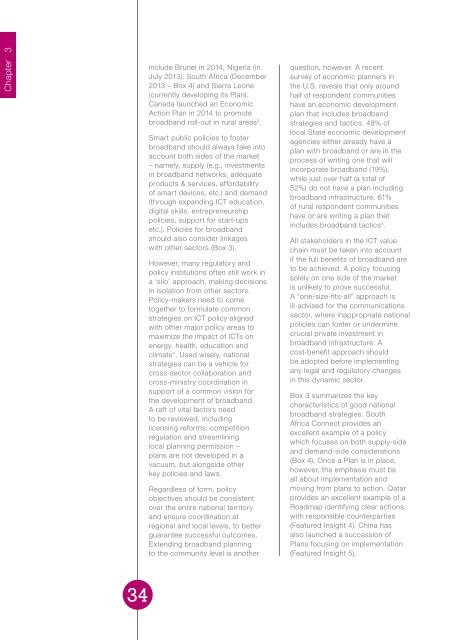DI8xz
DI8xz
DI8xz
You also want an ePaper? Increase the reach of your titles
YUMPU automatically turns print PDFs into web optimized ePapers that Google loves.
Chapter 3include Brunei in 2014, Nigeria (inJuly 2013), South Africa (December2013 – Box 4) and Sierra Leone(currently developing its Plan).Canada launched an EconomicAction Plan in 2014 to promotebroadband roll-out in rural areas 3 .Smart public policies to fosterbroadband should always take intoaccount both sides of the market– namely, supply (e.g., investmentsin broadband networks, adequateproducts & services, affordabilityof smart devices, etc.) and demand(through expanding ICT education,digital skills, entrepreneurshippolicies, support for start-upsetc.). Policies for broadbandshould also consider linkageswith other sectors (Box 3).However, many regulatory andpolicy institutions often still work ina ‘silo’ approach, making decisionsin isolation from other sectors.Policy-makers need to cometogether to formulate commonstrategies on ICT policy alignedwith other major policy areas tomaximize the impact of ICTs onenergy, health, education andclimate 4 . Used wisely, nationalstrategies can be a vehicle forcross-sector collaboration andcross-ministry coordination insupport of a common vision forthe development of broadband.A raft of vital factors needto be reviewed, includinglicensing reforms, competitionregulation and streamlininglocal planning permission –plans are not developed in avacuum, but alongside otherkey policies and laws.Regardless of form, policyobjectives should be consistentover the entire national territoryand ensure coordination atregional and local levels, to betterguarantee successful outcomes.Extending broadband planningto the community level is anotherquestion, however. A recentsurvey of economic planners inthe U.S. reveals that only aroundhalf of respondent communitieshave an economic developmentplan that includes broadbandstrategies and tactics. 48% oflocal State economic developmentagencies either already have aplan with broadband or are in theprocess of writing one that willincorporate broadband (19%),while just over half (a total of52%) do not have a plan includingbroadband infrastructure. 61%of rural respondent communitieshave or are writing a plan thatincludes broadband tactics 5 .All stakeholders in the ICT valuechain must be taken into accountif the full benefits of broadband areto be achieved. A policy focusingsolely on one side of the marketis unlikely to prove successful.A “one-size-fits-all” approach isill-advised for the communicationssector, where inappropriate nationalpolicies can foster or underminecrucial private investment inbroadband infrastructure. Acost-benefit approach shouldbe adopted before implementingany legal and regulatory changesin this dynamic sector.Box 3 summarizes the keycharacteristics of good nationalbroadband strategies. SouthAfrica Connect provides anexcellent example of a policywhich focuses on both supply-sideand demand-side considerations(Box 4). Once a Plan is in place,however, the emphasis must beall about implementation andmoving from plans to action. Qatarprovides an excellent example of aRoadmap identifying clear actions,with responsible counterparties(Featured Insight 4). China hasalso launched a succession ofPlans focusing on implementation(Featured Insight 5).34


